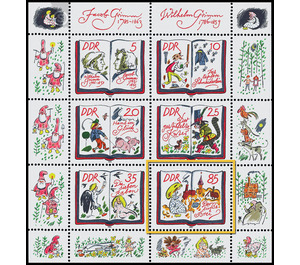Commemorative stamp series - Germany / German Democratic Republic 1985 - 85 Pfennig
Theme: Architecture
| Country | Germany / German Democratic Republic |
| Issue Date | 1985 |
| Face Value | 85.00 |
| Color | multi-colored |
| Perforation | K 13 1/2: 13 |
| Printing Type | offset |
| Stamp Type | Postage stamp |
| Item Type | Stamp |
| Chronological Issue Number | 2734 |
| Chronological Chapter | GER-DDR |
| SID | 79105 |
| In 22 Wishlists | |
200th birthday of Jacob and Wilhelm Grimm On the occasion of the 200th birthday of Jacob and Wilhelm Grimm, the Ministry of Posts and Telecommunications of the German Democratic Republic publishes six multi-colored special postage stamps. The special postage stamps are printed on a miniature sheet with border design. No Special First Day Cover Special cancellation from 26th November 1985 to 25th January 1986 200th birthday of the brothers Jacob and Wilhelm Grimm This series of stamps is dedicated to commemorating the 200th birthday of Jacob Grimm in this and that of his brother Wilhelm next year. Jacob (January 4, 1785 to September 20, 1863) and Wilhelm (February 24, 1786 to December 16, 1859) Grimm are among the co-founders of German studies as a science of the development of the German language and literature. With their work on German grammar, the history of the German language, the "German Dictionary" and the publication of medieval texts they created the basics. As upright democrats they entered Göttingen for the preservation of the constitution. Best known were the Brothers Grimm with their collection of "Children's and Household Tales". Inspired by Clemens Brentano and Achim von Arnim, on whose folk-song arrangement "Des Knaben Wunderhorn" they had worked, in 1807 they began to collect fairy tales. In processing these fairy tales the brothers had arrived at "faithfulness and truth" of the content. The poetic form, however, they regarded as their property. Here they understood how to hit the real folk tone. Of the many variants that they found in the course of their collecting activity, the most original and characteristic one was chosen in the final writing. The masterly literary formation of these models is above all the merit of Wilhelm Grimm. He supervised the other editions and increased and improved the fairy tale collection to the end of his life. Through the use of proverbial phrases and popular comparisons, through sound painting and repetitions, he developed the classic fairytale style, which has lost none of its effectiveness today. For Christmas 1812, the first volume of children's and house fairy tales had appeared in a still unappealing configuration and without illustrations. Only the two volumes of the second edition in 1819 each received a copperplate engraving of the youngest brother Ludwig Emil Grimm. In reprints and later editions, many important artists have illustrated the Grimm fairy tale u. a. Ludwig Richter, Moritz von Schwind, Theodor Hosemann, Heinrich Vogeler, Hans Baluschek, Josef Hegenbarth, Lea Grundig and 1963 Werner Klemke. Today, the fairy tale collection is one of the most widely distributed and translated works of world literature. Although the Brothers Grimm had not thought specifically of children as readers in collecting and editing the fairy tales, they soon became the most popular children's reading. Especially numerous are selection books with the most beautiful fairy tales. Some of these fairy tales are shown in the stamp series. The basic motif of the fairy tale "The sweet porridge" (85 pfennig value) is ancient. It is a magic gift that belongs only in the hands of the right owner. Even Lucian tells a lie fairy tale of the broom, which constantly carries water, you just have to know the call. The edges of the stamp sheet are provided with further illustrations, on which the illustrated fairy tales can be easily recognized. They are "Snow White", "Hansel and Gretel", The Bremen Town Musicians "," Little Red Riding Hood "and" Rumpelstiltskin ".


